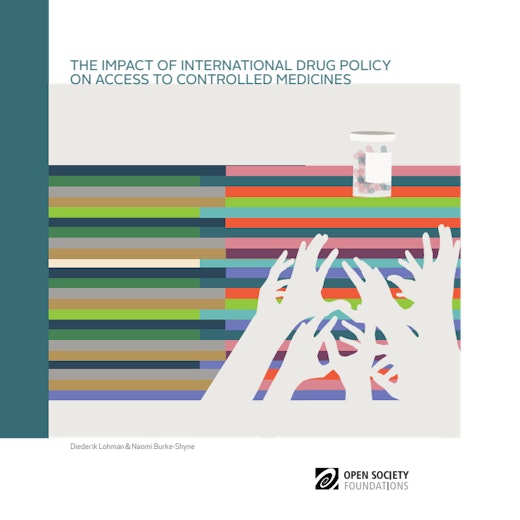
How does drug control policy undermine access to medicines?
Virtually all governments have laws and regulations that control the public’s access to substances judged to be potentially harmful. Some of these controlled substances may have medical or scientific uses, yet they are inaccessible to people who could benefit from them. The result is that tens of millions of people suffer because they lack access to essential medicines.
What is the impact on people’s health?
Some 75 percent of the world’s population—about 5.5 billion people—live in mostly low- and middle-income countries in which effective pain-relieving medicines are largely inaccessible.
For instance, more than five million terminal cancer patients and one million end-stage AIDS patients suffer from severe pain every year. Still others are forced to upend their lives to access the medicines they need—two-year-old Tristan Forde suffered 20 seizures a day until his family moved from rural Ireland to Colorado to legally access the medical marijuana that finally eased his suffering.
Many of these patients could benefit from morphine, the gold standard for the treatment of severe pain. Morphine is not expensive, but many governments severely limit its use. Over 90 percent of all morphine is used in a small number of high-income countries that are home to only 17 percent of the world’s population.
Does drug control policy affect access to medications used for mental health as well?
Yes. Numerous psychotropic medicines, antidepressants, and a wide range of antipsychotic medicines are unavailable to millions with psychosocial disabilities. Medicines prescribed to treat addiction are outlawed in some countries, or so tightly regulated that they are available to very few. Medicines that block psychotropic effects of illegal drugs are prioritized as treatment over those that may be more effective and affordable, but are deemed to have a potentially mood-altering effect.
How does drug control policy affect research into new medicines?
Drug policy can undermine research that could uncover the medical value of many substances. For example, cannabis and related compounds known as cannabinoids have been shown to treat childhood epilepsy, and relieve pain and nausea associated with cancer and chemotherapy. But the use, sale, and production of medical cannabis remain overly regulated or even unlawful in many countries, and research on their benefits restricted.
Some indigenous peoples have centuries-old traditions that involve ritual or therapeutic use of plant-based psychotropics, including psychedelic substances such as ayahuasca and peyote. Research into the medical benefits of these substances is similarly nonexistent or heavily restricted in most countries.
Aren’t these controls necessary for governments to protect the public from substances that could harm them?
Harmful drug use is certainly a public health problem, but in many countries, drug control policies lean too heavily towards limiting access to medicines for which patients have a legitimate and urgent need.
Of particular concern is access to opioid medicines, such as morphine, oxycodone, hydrocodone, and codeine, all essential medicines for the treatment of pain which are often heavily restricted. Methadone and buprenorphine (also opioid medicines) are essential for treatment of both pain and opioid dependence, but are grossly underused and overregulated.
Ketamine is considered by the World Health Organization (WHO) to be an indispensable anesthetic in low- and middle-income countries. Despite this, China has led global efforts to heavily restrict or even eliminate it, due to its hallucinogenic properties and potential for recreational use.
Who sets the guidelines for how these medicines are controlled?
The vast majority of countries are party to three United Nations drug conventions, which are meant to guide national decisions about which substances should be controlled. The UN is also meant to guide countries in determining whether or not a substance has medical or therapeutic use, and how to ensure availability of controlled substances for licit medical use.
The drug conventions designate WHO as the expert agency for determining the medical value of psychotropic substances, but too often WHO’s opinion is challenged because of security concerns, sometimes misguided.
Why don’t more political leaders and medical professionals challenge these policies?
Many factors conspire to keep controlled medicines inaccessible:
- Drug control authorities may not be adequately informed about the practical safeguards that can keep controlled medicines in the health system from being diverted to illicit use.
- Policymakers, health professionals, and the general public may harbor misinformed fears of addiction, or prioritize control of medicine supply over treatment for those in need.
- Physicians may fear prosecution under wide-ranging drug laws if they prescribe a controlled medicine that is somehow diverted.
- Health professionals may have to jump through so many onerous drug-control hoops—heavy paperwork requirements, limits on the prescription amount or duration, the need for special licenses—that they decide to avoid using controlled medicines altogether.
In many places, nonuse or underuse of controlled medicines simply becomes an entrenched reality: medical school curricula stop teaching on the subject of controlled medicines, and policymakers are inexperienced in crafting measures to meet the challenge of balancing drug control and access to medicines. In addition, drug manufacturers may compound these barriers by pressuring countries to purchase the most expensive formulations of controlled medicines, and health authorities may be unaware of affordable options.
What can be done to improve access to controlled medicines?
The UN General Assembly Special Session on drug control in 2016 urged governments to adopt balanced drug control policies that could be achieved in part by establishing a strong national authority to estimate the level of need for and ensure availability of controlled medicines, ensure adequate training for health professionals on their use, and establish effective but not unduly repressive antidiversion measures.
These measures are unlikely to succeed, however, unless the governance of drug control policy is also “balanced,” with health and social sectors on par with—and not dominated by—the security and policing sectors.
Read more
publication
The Impact of International Drug Policy on Access to Controlled Medicines

This report outlines the significant impact the international drug conventions have on access to controlled medicines, and sets out some recommendations for a meaningful debate at the UNGASS in 2016.
Vaccine Justice
Q&A: Africa’s Fight for Vaccine Equity

As the pandemic enters its third year, African Alliance founder Tian Johnson shares reflections on how to make progress in the push for vaccine equity and what African civil society organizations are asking for now.
Dignified End-of-Life Care
Governments Should Follow Moldova’s Lead and Ensure Universal Access to Palliative Care

Over decades, Open Society’s funding for palliative care has improved access globally. However, while philanthropy plays a large role in this sector, palliative care must ultimately be publicly funded and universally available.